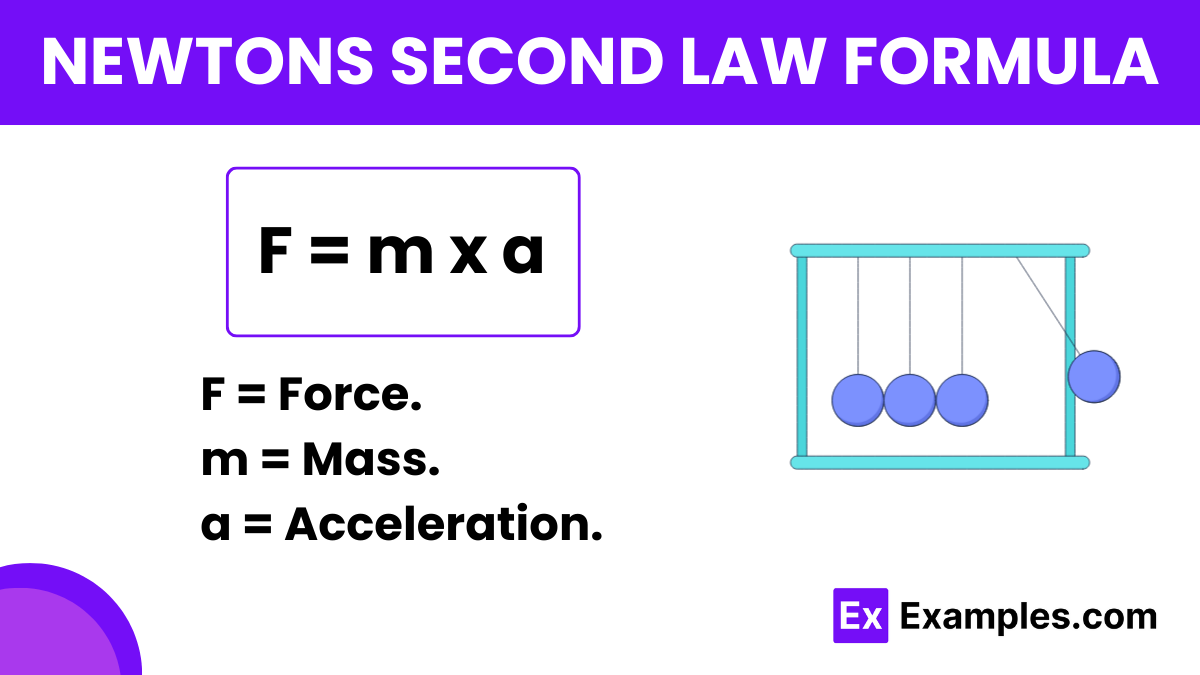What is Newton's Second Law of Motion?
F = ma
F = mv
F = m/a
F = ma²


Newton’s Second Law of Motion is fundamental in the world of physics, providing a quantitative description of the interaction between a force and the motion of an object. Sir Isaac Newton, a seminal figure in the Scientific Revolution, first introduced this law in the late 17th century. His work laid the groundwork for classical mechanics, radically changing our understanding of how objects behave in our universe.
The formula itself is expressed as
This equation tells us that the force applied to an object is equal to the mass of the object multiplied by the acceleration it undergoes. In simpler terms, the more force you apply to an object, the more it accelerates, and this acceleration is directly proportional to the force applied and inversely proportional to the object’s mass.
Understanding this formula is crucial in physics as it connects two fundamental properties: force and acceleration. It helps predict how objects will move when forces are applied, making it essential not only in theoretical physics but also in practical applications like engineering and technology. Newton’s formulation allows scientists and engineers to calculate either the force required to move an object at a certain acceleration or the acceleration that a certain force could produce on an object of known mass.
Question: A car with a mass of 1200 kg is required to accelerate from rest to 18 m/s in 12 seconds. How much force must the engine exert?
Solution:
Use the formula 𝐹 = 𝑚 x a.
First, calculate acceleration using 𝑎 = Δ𝑣 / 𝑡 where Δ𝑣=18 m/s and 𝑡=12 s.
𝑎=18 m/s / 12 s=1.5 m/s².
Now, apply Newton’s Second Law: 𝐹 = 1200 kg × 1.5 m/s² =1800 N.
Answer: The engine needs to exert a force of 1800 Newtons.
Question: A force of 500 Newtons is applied to a 50 kg crate. What is the acceleration of the crate?
Solution:
Use the formula 𝐹=𝑚𝑎.
Rearrange to find acceleration: 𝑎=𝐹 / 𝑚.
Plug in the values: 𝑎 = 500 N / 50 kg=10 m/s².
Answer: The crate accelerates at 10 m/s².
Question: A skateboard exerts a force of 300 Newtons and accelerates at 5 m/s². What is the mass of the skateboard?
Solution:
Start with the formula 𝐹=𝑚𝑎.
Rearrange to solve for mass: 𝑚=𝐹 / 𝑎.
Substitute the values: 𝑚 = 300 N / 5 m/s² = 60 kg.
Answer: The skateboard has a mass of 60 kg.
Newton’s Second Law states that force equals mass times acceleration (F=ma), linking force directly to the motion of an object.
Newton deduced the Second Law by observing and mathematically describing the behavior of objects under various forces.
The Second Law is considered real because it universally applies to all objects in motion, providing a reliable foundation for understanding dynamics.
Text prompt
Add Tone
10 Examples of Public speaking
20 Examples of Gas lighting
What is Newton's Second Law of Motion?
F = ma
F = mv
F = m/a
F = ma²
In the equation F = ma, what does 'm' represent?
Force
Mass
Acceleration
Momentum
If the force acting on an object is doubled, what happens to the acceleration, assuming mass is constant?
It is halved
It doubles
It remains the same
It quadruples
Which unit is used to measure force in the International System of Units (SI)?
Kilogram
Meter per second squared
Newton
Joule
What is the formula for acceleration if force and mass are known?
a = F/m
a = m/F
a = Fm
a = F²/m
An object with a mass of 5 kg is subjected to a force of 20 N. What is its acceleration?
2 m/s²
4 m/s²
10 m/s²
20 m/s²
If an object is accelerating at 3 m/s² and the force applied is 15 N, what is the mass of the object?
3 kg
5 kg
15 kg
45 kg
What happens to the acceleration of an object if the mass is tripled while the force remains constant?
It is tripled
It is halved
It is reduced to one-third
It remains the same
In the formula F = ma, what does 'a' represent?
Force
Mass
Acceleration
Velocity
A force of 50 N is applied to a 10 kg object. What is the object's acceleration?
2 m/s²
5 m/s²
10 m/s²
50 m/s²
Before you leave, take our quick quiz to enhance your learning!

